Vincent Van Gogh paintings once disputed
There have been several Van Gogh paintings once disputed, and later found to be authentic. Let us examine just a few:
The Oslo Self-Portrait (1889)
One of the most prominent Van Gogh paintings originally disputed is a self portrait acquired by Norway’s National Museum (Nasjonalmuseet ) in 1910. – The painting, also referred to as the Oslo self-portrait had long been contested, and this was largely due to the collaboration of color and also use of a palette knife.
In 2014, the National Museum in Norway and the Van Gogh Museum in Amsterdam agreed to carry out extensive joint research on the painting, and in January of 2020, they concluded that the work is in fact by the hand of Vincent Van Gogh.
Part of the research revealed that Vincent painted the self portrait during a psychosis episode whilst receiving treatment at the Saint Remy asylum. In a letter to Theo, dated 20 September 1889, Van Gogh referred to this self-portrait as “an attempt from when I was ill”;
“Today I’m sending you my portrait of myself, you must look at it for some time – you’ll see, I hope, that my physiognomy has grown much calmer, although the gaze may be vaguer than before, so it appears to me. (Vincent is referencing (F 627/JH 1772). I have another one which is an attempt from when I was ill. But I think this one will please you more, and I’ve tried to create something simple.”
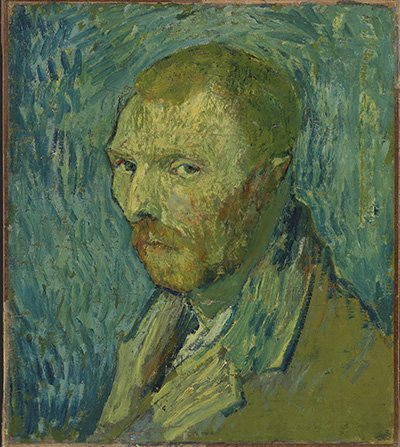
In 2006, the Nasjonalmuseet in Oslo discovered that the self portrait was given to Joseph and Marie Ginoux, proprietors of Café de la Gare in Arles (subject of the Night Cafe) where Van Gogh had lodged from May to September 1888. He most likely traded paintings for the room, because we are aware that Vincent had painted several portraits of Marie Ginoux, and we are aware that he occasionally traded his work or simply gave paintings to friends, and Vincent truly cherished his relationship with Madame Ginoux.
The Ginoux’s owned nineteen of Vincent’s paintings, all of which were offered for sale in 1895 to one of France’s most prominent art dealers of the time, Ambroise Vollard, and later to Lucien Molinard who commented on their damage. Sadly, many of the paintings owned by the Ginoux’s were not very well taken care of having suffered from damage and paint loss exposing the underlying ‘green paint’.
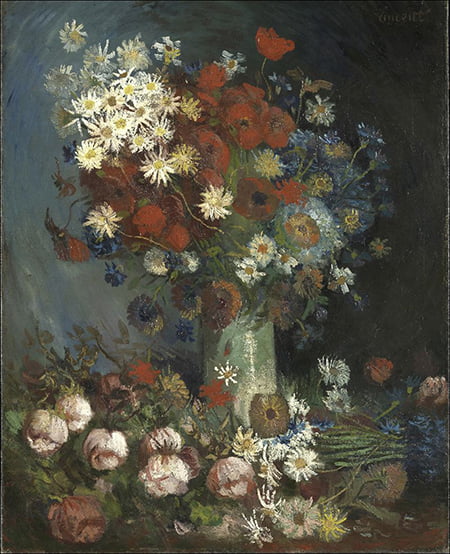
Still Life with Meadow Flowers and Roses
The Kröller-Müller Museum, which is home to the second largest Van Gogh collection, acquired Still Life with Meadow Flowers and Roses in 1974. Vincent painted several floral still life throughout his short career, and most of those while he was living with his brother Theo in Paris.
Many doubts were cast as to whether this still life was really by Vincent Van Gogh, so much so that in 2003 the museum attributed the painting to an anonymous artist. Indications were that the size was unusually larger than most Van Gogh canvases, the depiction of the flowers were too excessive, the style wasn’t consistent, and the signature was oddly placed top right.
The overly exuberant flowers, and thick layers of paint were determined as a method for concealing another painting. Researchers were aware from a previous x-ray that Still Life with Meadow Flowers and Roses was painted on top of two wrestlers, but a new and more in depth x-ray technique called (MA-XRF) allowed researchers to identify Vincent’s use of pigment and his brushstrokes.
Researchers also learned that the underlying wrestlers painting would have been created in 1886, while Vincent was attending the Art Academy in Antwerp since it was part of the academy’s course exercise. This would also explain the use of a larger canvas as they were standard format for figure paintings at the academy in Antwerp.
Vase with Poppies (F279 JH1104) 1886
A long-disputed Van Gogh painting donated by Anne Parrish Titzell to the permanent collection of the Wadsworth Atheneum in Hartford, Connecticut, was officially attributed to Vincent by the Van Gogh Museum in Amsterdam in 2019.
The painting had entered the Hartford museum’s collection in 1957, but in 1976 art historian Bogomila Welsh-Ovcharov queried the van Gogh attribution and in 1990, renowned art historian Walter Feilchenfeldt also raised concerns. At this stage, the painting was removed from display and placed into storage.
Feilchenfeldt was the author of several Van Gogh books including Genuine or Fake – On the history and problems of Van Gogh connoisseurship, and Van Gogh Fakes: The Wacker Affair.
However, as new technology came into play in the art world, researchers from the Van Gogh Museum concluded that the work is indeed by Van Gogh, and was painted shortly after he moved to Paris as was the case with most of his still life florals. – X-ray analysis and Infrared Reflectography also revealed that this painting is covering a self portrait.
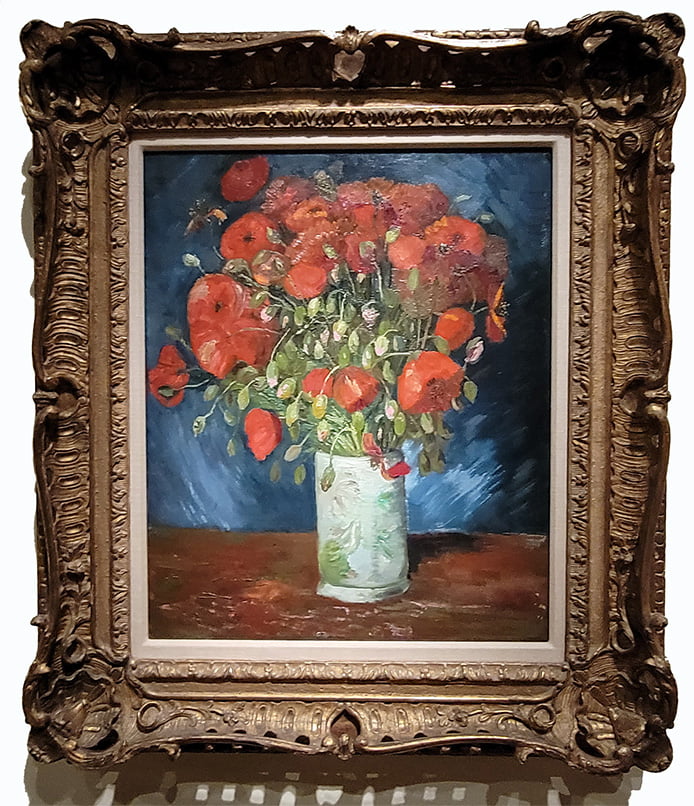
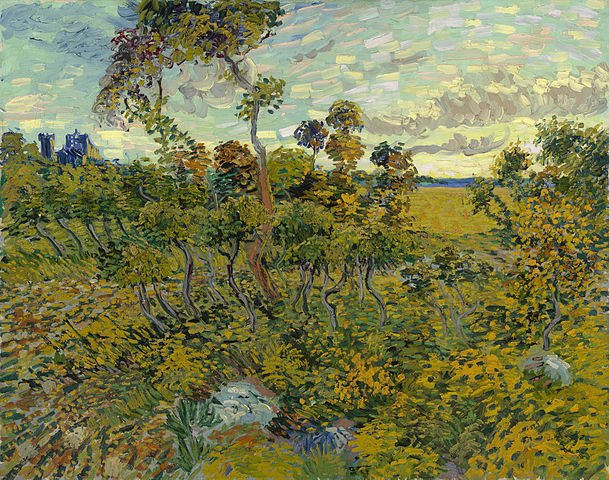
Sunset at Montmajour (1888)
The stunning landscape which was once part of Theo Van Gogh’s collection, was rejected by the Van Gogh museum in the 1990s, partly because it was not signed. In 2011 however, the museum carried out a two-year investigation and through a chemical analysis revealed the pigments were identical to others Van Gogh used on his palette at Arles – including typical discolorations.
If you look at Field with Irises near Arles (F409/JH1416), Farmhouse in a Wheatfield (F408/JH1417), and Wheatfield (F411/JH1476) all painted in May/June 1888, it is hard to imagine how Sunset at Montmajour was initially rejected.
Other evidence which confirmed the painting’s authenticity was a letter written by Vincent to his brother Theo on 5 July 1888, describing a landscape that he had painted the previous day:
“Yesterday, at sunset, I was on a stony heath where very small, twisted oaks grow, in the background a ruin on the hill, and wheatfields in the valley. It was romantic, it couldn’t be more so, à la Monticelli, the sun was pouring its very yellow rays over the bushes and the ground, absolutely a shower of gold. And all the lines were beautiful, the whole scene had a charming nobility. You wouldn’t have been at all surprised to see knights and ladies suddenly appear, returning from hunting with hawks, or to hear the voice of an old Provençal troubadour. The fields seemed purple, the distances blue. And I brought back a study of it too, but it was well below what I’d wished to do.”
On September 9 2013, the Van Gogh Museum held a public unveiling of the painting, announcing that the work is confirmed as a painting by Van Gogh.
Vase with Carnations (1886), bequeathed to the Detroit Institute of Arts in 1990 by Catherine Harriet Kresge Dewey, daughter of Sebastian Spering Kresge, founder of the S.S. Kresge Company which became K-Mart.
In 2010 the painting was included in the DIA’s exhibition Fakes, Forgeries and Mysteries, as ‘attributed to Vincent van Gogh’ and displayed alongside Van Gogh’s “Vase with Zinnias and Geraniums,” which was on loan from the National Gallery of Canada.
Microscopic examination later found layers of paint that were consistent with van Gogh’s canvases from the 1880s.
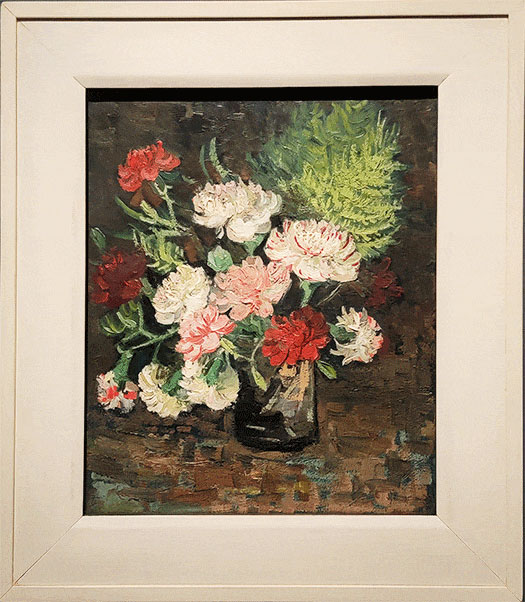
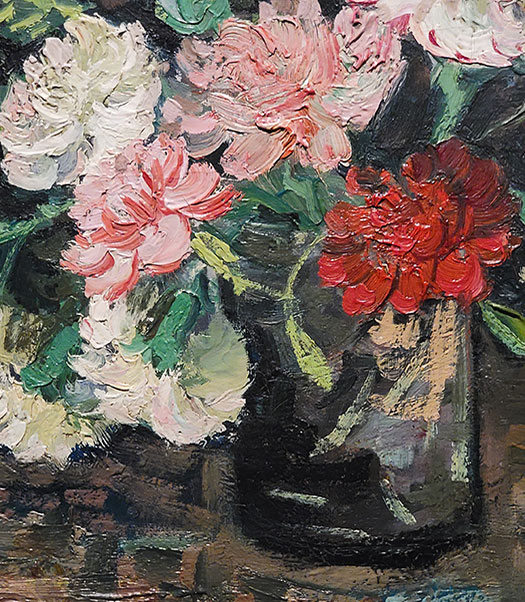
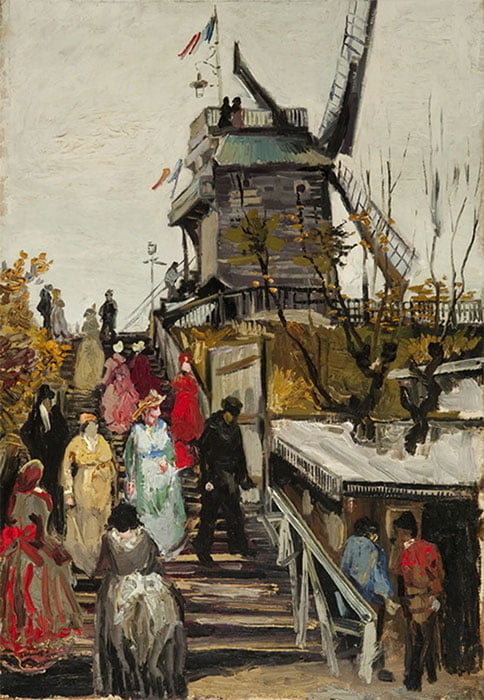
The Blute-Fin Mill (autumn 1886) was determined fake and had been excluded from Van Gogh’s oeuvre catalogs by de la Faille and Hulsker
In 1993, when the work went on display at the Museum de Fundatie, the Amsterdam experts apparently had no time to authenticate the painting and it went on display as “claimed” a Van Gogh.
Controversial art curator Dirk Hannema purchased the painting in 1975 from an antique and art dealer in Paris and was convinced the painting was genuine.
It was authenticated in 2010, the first Van Gogh work to be authenticated since 1995, and the sixth to be added to the confirmed list of Vincent’s paintings since Jacob-Baart de la Faille revised the catalogue raisonné in 1970.
Dirk Hannema passed away in 1984.
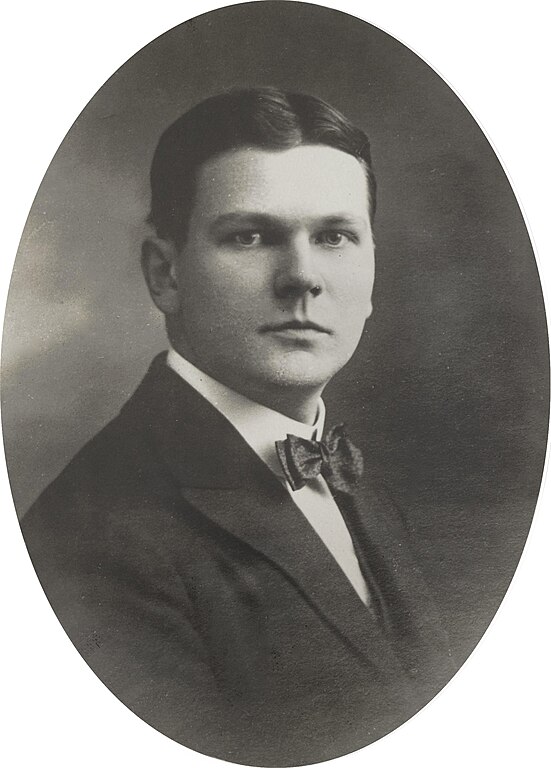
The only way to truly identify a Van Gogh painting as being authentic is by carrying out a series of tests; X-rays, Infrared Reflectography and other Multispectral Imaging such as Raking light and UVF, Paint Pigment Analysis, Signature Analysis, and potentially by Art Recognition algorithms which looks into brushstrokes and produces a heat map pinpointing which areas of the painting are more suspect .
The Wijk Mill (1883-1885)
The Wijk Mill is an interesting case. The only real authority to determine the authentication of a Vincent Van Gogh painting is the Van Gogh Museum in Amsterdam. The museum has been wrong in the past, and they have consistently rejected this one despite scientific proof, (according to the German auction house, Dechow).
Dechow had commissioned a chemical analysis, an art-historical report, as well an artificial intelligence–assisted investigation of the painting, and in September 2020 they auctioned off the painting for $651,000.
German art historian Ulrich Kuder, a professor at the University of Kiel in Germany also believes the painting is authentic and that Van Gogh created the painting between 1883 and 1885 while he was a student at the Hague School.
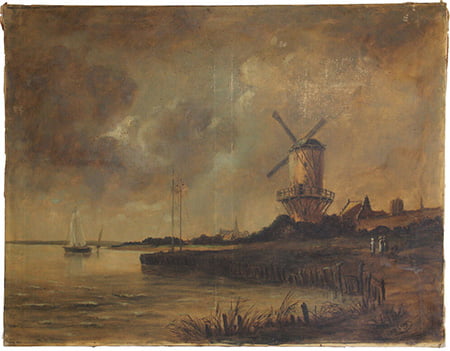
On Dechow’s facebook page they had posted the following comment with the picture included: “After Alexander Thamm GmbH analyzed the painting “The Mill of Wijk” with the help of AI and could not find any evidence of a forgery, the Bild has now also expressed its opinion and writes: “Genuineness with artificial intelligence proven. Computer solves Van Gogh puzzles”. The online auction starts today. Bids are possible from 08:00 to 18:00″.
It is important to note that the painting has still not received official authentication by the Van Gogh Museum in Amsterdam.
There are other paintings now believed to be the work of Van Gogh which were once ruled as inauthentic.
Still Life with Fruit and Chestnuts had long been rejected as artwork by Van Gogh, even as recent as 2013 when world renowned art dealer, publisher and Van Gogh scholar Walter Feilchenfeldt dismissed the painting as being authentic.
The small oil on canvas, was originally owned by California art collectors, Bruno and Sadie Adriani; the couple donated the still life to the Fine Arts Museums of San Francisco in 1960, where it was held in storage for some time given its questionable authenticity.
The inscription on the back of the painting reads “Nature mort, peint par Vincent van Gogh” (“Still Life painted by Vincent van Gogh”), and like many of Vincents paintings there is another composition underneath showing a woman.
The Still Life was painted in 1886, four years before Vincent’s death and was authenticated by the Van Gogh Museum in 2019, 133 years later.

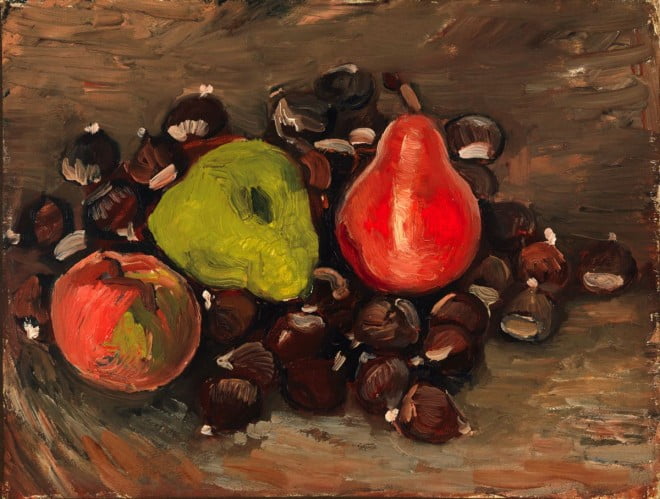
Dear All,
I’m the opinion to have in hands 3 , for sure 2 Van Goghs bought 30 years ago on a antiques market in Paris.
For further information my contacts.
Thank you.
Roberto Barnini
My question is, if I can send you some pictures of the paintings I have.
Thank you.